|
From: jeroen philippona
Sent: Monday, March 07, 2005 9:35 AM
To: Will Blozan
Subject: ENTS
Hello Will Blozan,
Some years ago I mailed you with some questions about big trees in the
eastern USA.
Being a tree lover myself, secretary of a local Dutch Tree Society, and
especially impressed by big and tall trees, I often visit the ENTS website,
to see the newest information about tall and big trees.
Your recent information about Congaree National Park is very interesting.
Apart from the loblolly pine the dominance of several oak
species as for size
is apparent. In GSMNP this is not the case, apart from some large
n. red oaks
and a few big tall chestnut and white oaks they do not seem to be among the
tallest nor biggest trees in that area.
From what I read in some reports on forest history in the eastern USA it
seems that oaks, especially white oaks, had a greater dominance in your
pre-settlement-forests than nowadays. I still think that they often attained
larger diameters and volumes than now in most forests, even GSMNP, can be
found.
In northwestern Europe there are as you will now relatively few native
tree-species because of the influence of the Ice Age. In the south en
especially south-east there are more species. The Caucasian region and the
north of Iran are in fact special rich regions while the period of
glaciation didn't have great influence there.
Different between Europe and the USA is also the much longer influence of
human culture in Europe. A lot of the oldest trees in Europe have been
planted by man; for example in Sweden there are rather many areas with old
open growth oaks: they were part of a very old pasture landscape were cattle
were grazing. There are remnant areas of this type as well in Germany and
Great Britain and they are often the areas with the most ancient trees.
In the Netherlands, a small and mostly flat country with cool summers and
mild winters, there are no natural old growth forests, except for some
oak-beech forests which probably never been clear cut, but rather heavy
exploited for centuries. Beside that we have only small secondary natural
forests not older than 100 years. Planted forests and smaller stands often
have older trees, some were planted before 1750.
The tallest trees in Holland nowadays are some stands of introduced
douglas
fir planted around 1870 near a royal palace. They are up to 170 feet tall
with cbh of 9 to 12 feet (photo DouglasLoo3).
|

Douglas Fir - photo by Jeroen Philippona
|
Hybrid cottonwoods (Populus deltoides x P. nigra, called P. x canadensis)
are by far the fastest growers and for that reason often the tallest trees,
100 to 120 feet is normal, some will be 130 to 140 feet.
Of native trees in Holland beech (Fagus sylvatica) often is the tallest. In
planted stands of 150 to 250 years old near estates of the 18th and 19th
century on good soils and more inland, so not to exposed to prevailing
winds, they often are 100 to 115 feet, but on the best soils they grow up to
130 or even 140 feet. I measured a fallen beech at 42 meter, 137.8 feet, in
an area belonging to a castle with tall alleys and forests.
The largest beech in these alleys, planted 1776, has a cbh of 4.9 m, 16 feet
and has a trunk volume which will be above 28 cubic meter (1000 cubic feet).
(photo Beukenlaan Middachten).
|
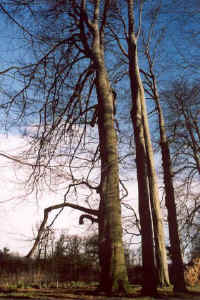
Beukenlaan Middachten - photo by
Jeroen Philippona |
Reports of this area give heights of beech of up to 47 m, 154.2 feet, but I
don't know how they measured them.
A friend of mine is arborist, he measured a beech in eastern Germany by
direct tape drop of 49 m, 160.76 feet. In Germany there are more reports of
beech of 46 to 49 m, 150 to 160 feet.
Beech is one of the most important forest hardwoods of NW Europe.
From your reports it seems that American beech doesn't reach quite the same
dimensions.
Other native trees wich can attain a large size are lime (Tilia cordata and
T. platyphylos and hybrid T. x europea for old growth individuals in
Bialowieza, Poland, see photos: Bialo-linde;
|

Bialo linde - photo by Jeroen
Philippona |

Bialo linde - photo by Jeroen
Philippona |
largest individuals 43 m/141
feet tall with CBH 5,8 m/19 feet, age Ī 350 years), European common ash
(Fraxinus excelsior), several varieties of elm (Ulmus glabra, U. laevis, U.
minor, etcetera, with various hybrids), common (or English) and sessile oak
(Quercus robur and Q. petraea).
In the Netherlands few of them grow taller than 100 to 110 feet.
Common oaks are the most abundant hardwood in great parts of NW and middle
Europe. Common oaks are rather slow growers, but in forests on the best
soils they can attain 110 to 120 feet after 200 years. In Germany, France,
Poland, the Chech republic and Kroatia (all have warmer summers than Holland
and larger, older forests on good soils) there are forests with common oaks
of 130 to 140 feet. The tallest common oaks grow on heavy soils in the
lowland regions.
In the large old growth forest of Bialowieza National Park, eastern Poland,
the oaks are up to 140 feet tall with a cbh of up to 656 cm, 21.5 feet. Here
the oaks are the trees with the largest trunk volume, up to 60 or 70 cubic
meter (2118.9 - 2472 cubic feet).
|

Q. robur Bialowieza Poland 42x6,2m - photo by
Jeroen Philippona |
(photo Q. robur Bialowieza Poland; this tree is easy to visit and has a
trunkvolume of 40 m3 =1412 cubic feet).
Very large forest grown common oaks have been reported in the past in
Southern Germany (one was 38 m tall with a wood volume of 88 cubic m = 3107
cubic feet) and in Kroatia.
In France and Germany the best planted oak forests are often with Sessile
oak, Quercus petraea. They do not grow on very rich, heavy soils but rather
light soils. They have a known planting history of up to 400 years. Here
forest oaks of 325 years old combine heights of 120 to 140 and perhaps 154
feet with a cbh of 10 to 16 feet, so they grow quite slow when compared to
cherrybark oaks and can better be compared with your chestnut and white
oaks.
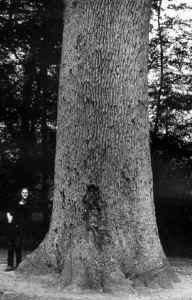
Sessile Oak - Q. petraea 35x6,8m
|
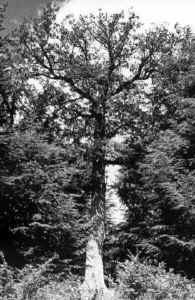
Sessile Oak - Q. petraea 35x6,8m
|
The sessile oak on the photo (Q.petraea France1+2) is 35 m (115 feet)
tall with a cbh of 6.8 m (22.3 feet) and seemed to be 450 years old.
The biggest forest grown sessile oak in France the last century was 32,6 m
(107 feet) tall with a circumference at breast height of 9.8 m (32.15 feet)
(photo Q.petraea France 32x9,8m). It died in 1927.
|
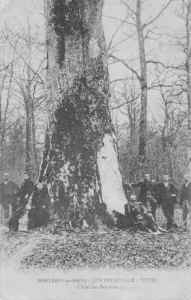
Q. petraea 32x9,8m photo from (Ī1900) |
The largest forest grown oaks as well as beeches seem to grow in large and
well preserved old growth forests in the north of Iran, south of the Caspian
and on the northern slopes of the Elburz Mountains. A group of German
foresters and forest academics has had an excursion there a few years ago
and reported oriŽntal beeches (Fagus oriŽntalis, see photo) of 50 m (164
foot) tall and over 2 m (6Ĺ foot) DBH
|
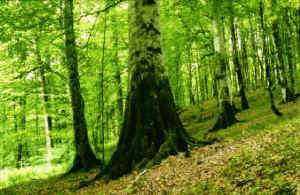
Fagus oriŽntalis - photo by Dr. Sperber |
and of Chestnut-leaved oaks (Quercus castaneifolia, see photo) of also
50 m tall and up to 3,5 m DBH. Local foresters told them there were even
larger circumference oaks. When these figures are right these western
Asia-oaks are larger than all European forest grown oaks and could have
wood volumes of over 100 cubic m (3500 cubic feet).
|
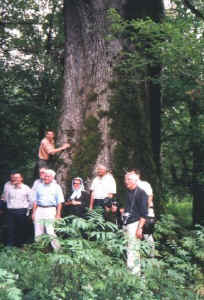
Quercus castaneifolia Ī50x10m - photo by
Dr. Sperber |
What Jess Riddle said (February 15th 2005) about the volume of open grown
opposed forest grown trees I think is right: the largest open growth oaks of
Europe are larger in volume than the largest forest grown (at least for Q.
robur and petraea). The same seems to be true for several broadleaf species
like Beech, Sweet Chestnut (Castanea sativa) and OriŽntal Plane (Platanus
oriŽntalis), of which in Greece and Turkey are very big specimens with huge
crowns and great circumference (up to at least 14 but perhaps 18 m (46 - 59
foot).
I show you pictures and measurements of three of the largest known open
growth common oaks (outside Russia and Turkey, of which there is little
information available).
1. The largest common oak of Ivenack, eastern Germany (former communist
part) has a height of 33 m/108,27 feet, (my measurement, the sign near the
tree gives 35,5 m/116,47 feet) and a CBH of 11 m (36,09 feet). At the sign
in front of the tree the wood volume is given as 180 m3 (6350 cubic feet).
Probably this is somewhat to much, but according to rough calculations by
Jeroen Pater and me the total volume of trunk and branches will be something
like 120 to 130 m3 (4237 to 4590 cubic feet).
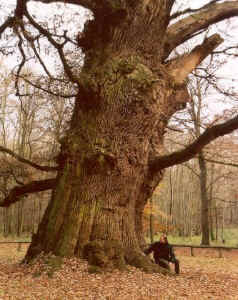
Q. Robur, Ivenack, Germany, 33x11m with Jeroen Pater - photo
by Jeroen Philippona
|

Q. Robur, Ivenack, Germany 33x11m - photo by Jeroen Pater
|
2. We do not know of another oak in Europe with a volume of over 100 m3
(3531 cubic feet) except perhaps Majesty, the Fredville Oak in Kent, England
(19 m /62 feet tall, CBH 12,2 m/40 feet), the trunk of which alone contains
over 80 m3 (2825 cubic feet).
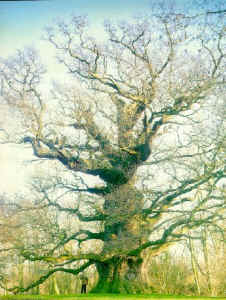
Fredville Oak 19x12,2m - photo by Thomas Pakingham's from his
first tree-book: "Meetings with remarkableTrees" |
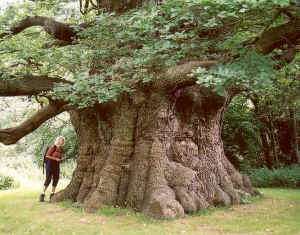
Fredville Oak 19x12,2m - photo by Jeroen Philippona
|
3. The Chrobry Oak of Piotrovich, Poland, (26 m (85 feet) tall, CBH 10 m, 33
feet) has a total wood volume of more than 80 m3 (2825 cubic feet).
As for ash: it needs fertile soils to grow realy tall. In Bialowieza it
becomes 140 feet tall with cbh of 14 feet.
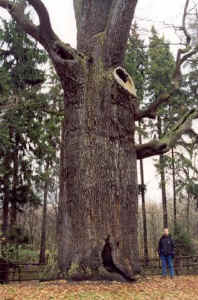
Chrobry Oak of Piotrovich, Poland 26x10m - photo by Jeroen
Philippona
|
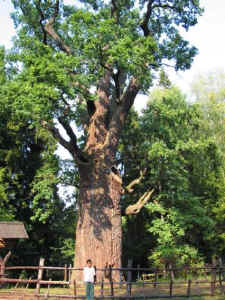
Chrobry Oak of Piotrovich, Poland - Internet photo
|
In southern Germany there is a forest on extreme fertile soil along the
Danube river near Kelheim, planted in 1843. The medium height of ash here is
42.6 m (140 feet), of common oak 40.9 m. The tallest ash is even 49.8 m
(163.4 feet) with CBH of 267 cm, wich is very near to your tallest white
ash. (alas I don't know the measure method, these figures are from a summary
of a scientific report in German on internet:
http://www.lwf.bayern.de/lwfbericht/lwfbericht34/kap14.htm
Tallest native trees of Europe are Norway Spruce (Picea abies) and White Fir
(Abies alba). Both species reach in several countries maximum heights of 160
to 170 and sometimes 180 - 190 feet. Heights of 200 feet (and more) are
sometimes given and could be possible, but to my knowledge have not been
verified. Trunkvolumes of Abies alba have been verified of over 50 cubic m
(1765 cubic feet).
For example, in Slovakia, in the forest-reserve Dobrocsky Prales, a White
Fir was 58 m (190,29 feet) with CBH of 475 cm (15,58 feet), another was 55
m (180,446 feet) with CBH of 607 cm (19,91 feet) and total trunk-volume 51,3
cubic meter (1811,6 cubic feet).
In the same forest Norway spruce is measured to 54 m (177,16 feet) and beech
to 46 m (150,9 feet).
In Bialowieza, Poland, Norway spruce is growing up to 50 m (164 foot),
sometimes 52 m (170,6 foot) and one was measured of 56 m (183,7 foot). CBH
maximum is about 4 m (13 foot).
I hope you like this information, and I hope to see some of your best
forests soon.
Jeroen Philippona
The Netherlands
From: Will Blozan
To: 'jeroen
Sent: Monday, March 07, 2005 9:49 PM
Subject: RE: ENTS
Jeroen,
I read your report with extreme interest! Thank you so much for the
extensive and informative descriptions of Europeís huge trees. I am truly
impressed with the heights obtained by the beeches and the oaks, especially
at such a northerly latitude. Do you know how the wood volume calculations
were made?
As are you, I am suspect of some of the height information. As described on
our website, conventional methods of height measurement can lead to huge
errors, especially on spreading hardwoods and leaning conifers. However, the
direct tape drop you mentioned suggests the heights listed are obtainable. I
would love to see (and climb) a 160í beech! WOW!
With your permission, I would like to place your report and the photos on
the ENTS website. It would generate much discussion and interest, and serves
as another comparison for our eastern forests. Please let me know, as it
would be a fantastic addition to our website!
Do you measure or climb trees? Also, are you a member of our email
discussion group? You might find it interesting, and any European
information would be welcomed. As you know, we often track European species
as indicators of site productivity. Norway spruce will reach 40 meters tall
here, but rarely over 1 meter diameter. European beech gets huge, but is
usually planted in the open and does not get nearly as tall as your native
trees. And yes, American beech is a rather short tree in general, but will
occasionally reach 40 meters.
Do you have any accurate information about European Ulmus species? U. glabra
can get fairly tall here, 39 meters in 100 years. Also, I know eastern white
pine (P. strobus) has been planted in Europe for 400 years. Do you know if
any original trees are still living and how large and tall they get? That
would be very interesting to know, as it is our tallest eastern tree.
Thanks again for your excellent report! If you do get to the US and want to
see the Great Smokies, please let me know and I would be glad to take you to
the ďgood stuffĒ. Incidentally, the only oaks in the Smokies that may reach
their maximum volume known may be northern red (Q. rubra) and chestnut (Q.
montana). Both species exceed 1.9 meters diameter, with Q. rubra reaching
2.07 meters. I measured a Q. rubra to 46.1 meters tall yesterday, a new
Smokies record. Q. montana reaches 42.7 meters, but is certainly smaller in
volume than Q. rubra. Our largest Q. rubra likely reaches 26-2700 cubic feet
and is 41.5 meters tall (I have attached a few photos of the tree). We have
one species over 4000 cubic feet; tuliptree (Liriodendron
tulipifera).
Take care,
Will
From: jeroen philippona
To: Will Blozan
Sent: Tuesday, March 08, 2005 2:15 PM
Subject: Re: ENTS
Will,
thanks for your kind response.
Of course you can place my report on your ENTS website; as I found some
small omissions, please use the one below.
As for the photos, some are mine, some are not. The picture of the Fredville
Oak is from Thomas Pakingham's first tree-book: "Meetings with remarkable
trees"; it was already posted on internet, but when you place it, please
give a reference to his book. I send you a picture of my own, but this is
only of the trunk.
The picture of the Polish oak of Piotrovice in summer with a child in front
is taken from a website on internet. The other of this tree is my own.
The photo of the oak of Ivenack as a whole is of Jeroen Pater, who is
sitting beside it at the other photo, which is my own.
It is also at his website on old trees in Europe, at
http://home.planet.nl/~pater510/ .
The two photos from Iran are of Dr. Sperber, a now retired German scientist.
The old photo of a French oak in 1900 I found on internet but has no
copyright. The other photos are mine. So if you refer to these photographers
it is ok.
More of my pictures and information you can find at my own website on trees:
http://vossen.xs4all.nl/bsz/jpa/ . This is in Dutch and in English but the
Dutch part is about 3 times as large as the English part.
Some reactions:
I do measure tree-circumferences, but heights not in your professional way: I
don't have laser equipment and only sometimes had the use of a clinometer /
hypsometer. I mostly estimate the height by hand and with a stick and a
pole, but am very careful in making as good as possible estimates. I know of
the problems arising from measuring false tops of a leaning or
broad-crowned
tree, so try to find the real top and measuring from the position below this
right top.
Indeed many mismeasurements are made in Europe like in the USA: in the Dutch
tree-register of the Dutch Tree-society (in Dutch:
Bomenstichting) there
are a lot of over-estimates, for example according to them the tallest
Plane-tree is given as 41 m (134,5 foot), but is to my estimate only 31 m
(101,7 foot). (Several other planes in Holland are up to at least 35 m (115
foot), but 41 m is not proven yet).
Height measurements in Holland as well as northern Germany are often less
difficult as in GSMNP, being very flat countries and often open growth or
small woodlands were you can walk a good distance to have good view of the
tree.
I do not climb trees, I'm not an arborist like you or professional
tree-researcher such as Bob van Pelt.
I'm not a member of your e-mail group (while not living in the eastern US
and not measuring heights by laser equipment) although I quite often visit
your website.
I am just an amateur tree-lover, I am secretary of the local Tree Society of
my town Zutphen and surroundings and contact person for the Dutch Tree
society. I did study for teacher in Biology and Geography and in the
beginning of the eighties worked at an institute for nature research on
landscape-ecology, especially forests and birds.
Because of the relatively warm Gulf stream, coming over the Atlantic from
the Caribbean to NW Europe, winters are very mild in NW Europe, especially in
Ireland, Great Britain, western France, Belgium, West Coast of Norway and
Holland, but this influence can be remarked all over Germany and even in
Poland. From west to east at the same latitude winters are getting severer
all the way up to eastern Siberia. So in NW Europe winters are much milder
than in New England or the Great Lake district in the USA. In stead,
especially in the NW summers are rather cool and wet. So Great Britain has
a very favorable climate for the great conifers of NW USA and in the last 1Ĺ
century have grown quite tall and big specimens of them, with several Giant
Sequoias with CBH of 9 to 11 m (30-36 foot) and up to 52 m (170 foot) tall
(laser-measured by the Tree Register of the British Isles), Douglas Fir up
to 62 m (203,4 foot), Grand Fir 61 m (200 foot) and Sitka Spruce at least 58
m ( 190 foot), all laser measured by the Tree Register.
The Eastern white Pine (Pinus strobus) doesn't perform as well in Europe,
partly because they get a Pine blister-rust so rarely get very old, original
trees are probably all gone. The tallest in Great Britain are 42 and 41m
with DBH of 113 and 102 cm, according to the Tree Register, probably
reliable measured; the first was planted in 1787 and will be one of the
oldest remaining. In the near past the late dendrologist Alan Mitchell gave
a height of 43,9 m, 144 foot, but his heights taken with a hypsometer, were
not always correct. I don't know what are maximum heights in Holland or
other European countries.
Norway spruce rarely becomes bigger than 13 feet, the largest I know of was
in the Tsjech Republik, in the forest reserve of Boubin, with a height of 57
m (187 foot) with DBH of 160 cm. Its height was controlled after it fell
1970 December 4. Another in the same forest had a height of 55 m and a
volume of 38 cubic m. These figures are from a book on forests in
Czechoslovakia of 1981.
As for Ulmus, many large and tall trees died of Dutch elm disease. The
tallest in Holland now seem to be 32 m, in Great Britain there are some of
38 to 41m, one U. glabra is given as 42 m, and some hybrids have been
measured in the past up to 46 m, but these measurements are not totally
reliable.
I didn't write about the reliability of several
height measurements, for
example of beech, Norway spruce, White fir and oaks in several European
countries. I'll do that next time, having little time at this moment.
I'll write more soon,
Jeroen
| RE:
European Trees/ Boogerman Pine |
Will
Blozan |
| Mar
16, 2005 12:23 PST |
ENTS,
I highly recommend a visit to these websites. They are
fantastic! Also, note
the climb and tape drop info on some of these trees- very
impressive! I had
no idea trees could be so tall in Europe.
Will
|
| Re:
European Trees, worldwide trees |
MICHAEL
DAVIE |
| Mar
16, 2005 15:00 PST |
This is all a bit off of eastern native trees, but...
It's funny, the week before BVPs email about Mexico I was
looking around for
information on pines and other more northerly species that
grow down into
central America in the mountains. Pines, oaks, sweetgums,
hickories, I'd
love to see them down there. World Wildlife Fund and
National Geographic
have got a very interesting site with information on
forest types around the
world http://www.nationalgeographic.com/wildworld/terrestrial.html
and
mentioned some of the pine-oak forests in Honduras
"In the Olancho area of
Honduras, the trees reach exceptionally large stature,
creating an
especially regal forest." Hmmm.
What's also funny is that a week or so ago I was looking
at Jeroen's site,
which is great. There's a link on his site to another site
with old photos
and postcards. There's one oak from Bosnia-Herzegovina
that apparently fell
in 1998, though I couldn't find any other references or
later pictures than
this: http://home.hetnet.nl/~jeroen09/famous%20oaks.htm
. The trees in Iran
sound awesome, I didn't know about that area, it sounds
like the region of
northeast Turkey that gets tons of rain off of the Black
Sea. Also in
Turkey, going into the Caucausus mountains including most
of Georgia, parts
of Azerbaijan, Armenia and a little bit of Russia are
forests that might
also have lots of huge trees. When I went to Turkey I
didn't even know these
places existed, or I would've made a point of going there.
I did see some of
the giant Oriental plane trees that Jeroen talked about.
It's really fun if a little difficult to find out about
great forests of
the world via the internet. It's also frustrating because
there are so many
amazing places I know I'll never get to go to, but
hopefully at least some
that I can. New Guinea, New Zealand or Borneo, maybe?
Tasmania, Japan, or
the taiga of Siberia? Scrub forests of the high Andes, the
Congo basin.
Whatever, it's all good. It's also great here in the
eastern U.S., lucky for
us. |
|